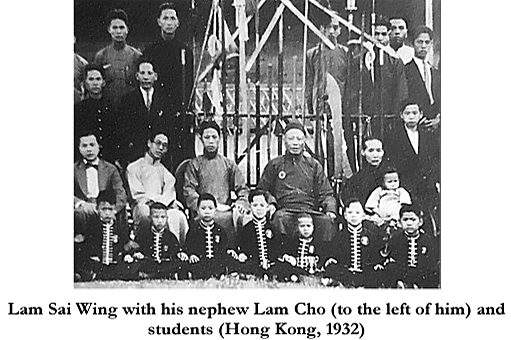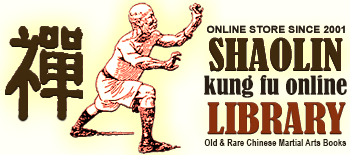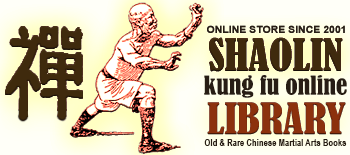
"The correct movement of Dong makes a fighter fast and powerful like the tiger and gives the strength to move off a mountain..."
"From my own experience I know that the most impressing thing in Tid Sin Qi Gong is that the physical strength of those who train themselves can be increased by nine times. It is hard to believe for those who did not practice this method..."
"This method is the best for those who practice the Martial Arts. Thanks to this method, I myself could achieve my tutor Wong Fei Hung's results and Master Fei Hung could achieve the results of honorable tutor Lam Fook Sing who in his time was the best disciple of Tid Kiu Sam, the unsurpassed Master."
Lam Sai Wing.
Iron Thread. Southern Shaolin Hung Gar Kung Fu Classics Series (Hong Kong, 1957)
Bibliography: Lam Sai Wing
Iron Thread. Southern Shaolin Hung Gar Kung Fu.
Priceless Heritage of Southern Shaolin Inherited from the Past and Handed Down by Venerable Grandmaster Lam Sai Wing.
The Iron Thread Form (Tid Sin Kuen) was created by Tid Kiu Sam (Iron Bridge III), one of the best martial artists in the history of China. His real name was Leung Kwan (1813-1886). He was one of the famous Ten Tigers of Guangdong. Tid Kiu Sam was born in the town of Nanghai, Guangdong province. He, the third child in the family, became a disciple of a monk from the Southern Shaolin Temple, Gwok Yan. Gwok Yan was one of the greatest masters of the Southern Shaolin Hung Gar Kuen school. He was known along the whole length of the Yangtse river. Through the years Tid Kiu Sam passed his knowledge down to one of his students, Lam Fook Sing. Some time later Lam Fook Sing taught Wong Fei Hung (1847-1924) and the latter Wong Fei Hung taught Lam Sai Wing (1860-1943).
The Iron Thread is considered as the highest form taught in the traditional Southern Shaolin Hung Gar Kung Fu system. This method belongs to a branch of "hard", or fighting Southern Shaolin Qi Gong (Chi Kung) and considered as "Internal Training". A master of the Iron Thread can withstand, with no consequences, the strongest of blows, including ones with heavy objects or cold steel, bend thick iron rods with his hands, and his "rooting power" is so strong that he cannot be displaced by a group of strong people. In addition, this wonderful method strengthens all internal organs, bones, muscles and sinews. The entire body thrives and rejuvenate.
Foreword by Li Shi Hui. Hong Kong, the summer of Din You Year (1957).

About the Author

Lam Sai Wing
Lam Sai Wing (1860 - 1943) was born in the district of Nan Hai, Guangdong province. Followed the customs of ancestors and learnt the tradition of Martial Arts in his family, proceeded to learn from tutors Lam Fook Sing, Wong Fei Hung, and Wu Gum Sin. Indulged in persistent training, achieved great mastership in the Martial Arts. Founded Wu Ben Tang ("The Hall of Fundamental Study") in Guangzhou (Canton) where he taught the Martial Arts. During his life brought up more than 10,000 followers.
Toward the end of the Qing dynasty (1644 - 1911) gained the first place at large competitions that took place at the Dongjiao ground. Thanks to it, with great pleasure, Lam Sai Wing received a silver medal handed to him by Dr. Sun Yat-Sen himself as a token of the recognition of his great services and successes. In the years followed, taking images and characters of the Tiger and the Crane as a base, as well as techniques of Hung Gar Kuen and Fo Kuen styles, he founded a new school Fu Hok Seung Ying Kuen ("The Double Form of the Tiger and the Crane").
Lived in his old years in Hong Kong where he taught the Martial Arts together with his favorite disciples Juy Yu Jaai, Jeung Sai Biu, Lei Sai Fai, and others. Wrote books: GUNG GEE FOOK FU KUEN ("Taming the Tiger"), TID SIN KUEN ("Iron Thread Fist"), and FU HOK SEUNG YING KUEN ("The Double Form of the Tiger and the Crane").
Marked a new epoch and a new school of Chinese Martial Arts, in particular in the division of formal complexes Tao Lu. Fu Hok Seung Ying Kuen ("The Double Form of the Tiger and the Crane") is practiced on a large scale both in China and abroad and the interest to it does not fall down. After the formation of the People's Republic of China (1949) this style was included into syllabuses of institutes and Wu Shu high-grade schools.
/ An article from ZHONG GUO WU SHU ZEN MING CI DIAN - Dictionary "Well-known Masters of the Chinese Martial Arts" edited by Chang Cang and Zhou Li Chang. /

More about Lam Sai Wing:
Short Historical Essay on Master Lam Sai Wing. Written by His Disciple Zhu Yuzhai
As related by Zhang Shibiao from Pangyu. The twelfth year Kuihai of the Peoples Republic (1923), the first month of the summer.
BOOK details
- CreateSpace (USA, 2008)
- English
- 186 pages / 6 x 0.5 x 9 inches
- 1440475008
- 978-1440475009
The book presents full description of exercises and requirements to their execution.
"Each kind of Gong Fu has its own method of training and its own secrets. This book just gives the most complete and visual guidance for correct training in Tid Sin. It is indispensable for all who practice Qi Gong and Gong Fu."
/Lei Sai Fai/
Short Historical Essay on Master Lam Sai Wing. Written by His Disciple Zhu Yuzhai (1923).
Master Lam Sai Wing (1860-1943) was born in Pingzhou district of the southern Guangdong province. He was a generous, bright and witty boy who from his childhood strove for knowledge and did well in traditional classic sciences. His esteemed ancestor Lam repeatedly told him that talent and persistence are a good base to form one's character.
Besides, as far as Chinese pugilistic arts and sword fencing are concerned, the past period, when fighting techniques were secretly trained, should serve as an example. So, the second factor of success is to follow the ancient methods.
Master Lam Sai Wing learned Gong Fu for many years and had long experience, yet he could not be self-confident and humbly gained knowledge of ancient times in his desire to comprehend the innermost essence of the art. His disciples Hu Jinxin and Shao Zhang Bo helped him in that. Later, they could not go on with their training and set up butcheries to earn their living. Only Master Lam, full of high aspirations, did not forget the ancient directions and diligently and indefatigably reared the art in his soul. It cannot but give rise to our admiration, indeed!
That was the time when Manchu dynasty Qing (1644-1911) fell down and the People's Republic (1912-1949) was in the process of formation. The Chinese people had no moral supports during that time of confusion and lawlessness. At quiet nights Master Lam Sai Wing meditated on how to devote himself to good deeds and heavily sighed. He said that at such a time a brave man could not waste his powers and had to do his highest duty for the sake of the people. One must devote to it his whole life, refuse trade and handicraft, "take a knapsack on his back and set off" in search of friends and mentors for himself to enrich his knowledge... / Continue reading >








